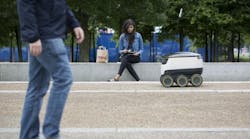Imagine a six-wheeled robot about the size of a suitcase rolling down a bustling city sidewalk and delivering packages to local businesses, elderly, and young professionals short on time.
Suddenly, a boy jumps in its path, and the robot veers, missing him by inches.
This is not a sci-fi movie scene, rather a likely street view in the not-too-distant future. Robots are marching toward everyday life, hoping to blend into the hustle and bustle of society. But are we really safe with them around?
"It is important in terms of social acceptance as well as safety that people are able to predict a robot's behavior," says Matthew Walter, an assistant professor at Toyota Technological Institute in Chicago.
Robots are already appearing on sidewalks in select cities. Estonia-based tech startup Starship Technologies just tested its delivery robot four weeks ago in San Francisco. The turnover of professional service robots, such as those in healthcare and logistics, will grow to $23.1 billion for the period 2016-2019, compared to $4.6 billion in 2015, according to the latest report by the International Federation of Robotics.
The unpredictable nature of sidewalks presents an especially difficult challenge for robots, from inattentive adults staring into phones to absent-minded children playing imaginary games to harried professionals rushing out of buildings. Then there are critical moments of interaction with car drivers and bicyclists.
"I think probably one of the biggest challenges is dealing with pedestrians, navigating around pedestrians, and predicting their behavior," Walter says.
All of which begs the question: How quickly can robots respond to encounters with humans?
Starship's robot travels at pedestrian speed – about four miles per hour – and uses computer-vision technology, such as GPS and proprietary mapping, to pinpoint its location to the nearest inch. It has a sophisticated obstacle avoidance system that acts as a "bubble of awareness" around the robot preventing it from bumping into things, says Henry Harris-Burland, marketing and communications manager at Starship.
"Let's say the system fails," he says. "The worst thing that can happen is the robot just comes to a slow stop. It stops in 30 centimeters, which is a very safe stop distance."



